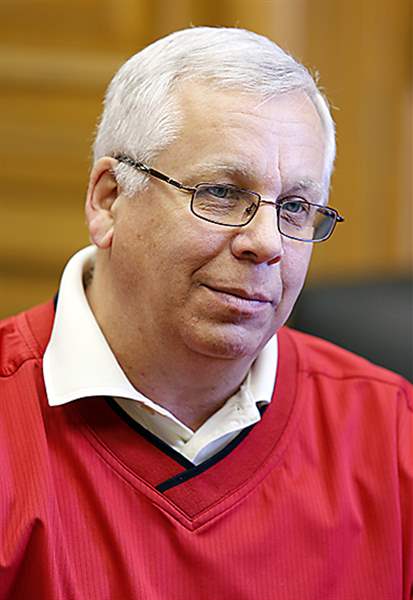
COMMENTARY
Ohio’s right-to-work sideshow can’t become main event
The real discussion Ohio needs to conduct is about job creation and economic revival
1/12/2014
Lortz
ANDY MORRISON

We Are Ohio, a labor-backed advocacy group formed to fight Senate Bill 5, conducted a right-to-work informational meeting in November at the downtown Toledo-Lucas County Public Library.

Dave Kushma
The right to work. Workplace freedom. No hard-working, hard-pressed Ohioan could resist such benign-sounding slogans, right?

Lortz
That’s the expectation of business and ideological lobbies that want to make Ohio the 25th “right to work” state, as soon as this year. Labor leaders, liberal advocacy groups, and community organizations, in Toledo and across the state, hope that Ohioans will lift the rhetorical gauze and reject right-to-work as decisively as they voted to repeal the union-busting Senate Bill 5 three years ago.
Right-to-work advocates seek a new state law that would prohibit Ohio employers and unions, in the private and public sectors, from requiring workers to join a union and pay dues as a condition of employment. Proponents also want to outlaw “fair share” fees for workers who refuse to join unions; such fees cover the costs of collective bargaining on their behalf.
These provisions would allow free riders to enjoy the higher wages and better benefits negotiated by unions without helping to pay for them. They aim to discourage union membership, and thus weaken bargaining and political clout, in one of the nation’s citadels of organized labor.
Despite membership declines over the past 25 years, one of every eight Ohio workers still belongs to a union. The number of union-represented workers here — more than 600,000 — is the seventh highest among states.
“Right to work hurts everyone, not just unions,” says Ken Lortz, director of United Auto Workers Region 2B, which is based in Maumee and includes Ohio and Indiana. “These are not worker-driven initiatives. Workers aren’t saying: ‘We don’t want to pay our dues.’ Rich corporations and politicians across the nation are behind this. They want to tilt the playing field.”
Ohio’s right-to-work battle may be joined in 2014. Republican-sponsored bills before the General Assembly would execute the right-to-work agenda. Supporters continue to gather petition signatures to place a right-to-work proposal before voters as early as November’s general-election ballot.
The debate has heated up here since neighboring Michigan and Indiana became right-to-work states in 2012. Last year, an Indiana judge declared that state’s law unconstitutional, although it remains in effect while the ruling is appealed.
A recent report by the Mackinac Center for Public Policy, a free-market think tank in Michigan, applauds the effort “to free workers from forced unionism.” It concludes that “right-to-work states have seen improvements in average annual employment, real personal income, and population growth” that they wouldn’t have achieved otherwise.
The study’s authors assert “the evidence shows positive and statistically significant gains for states that take such a bold move.” The Mackinac Center acknowledges it’s too soon to tell how right-to-work is affecting the business climates in Michigan and Indiana.
When I spoke with Mr. Lortz last week, he had his own statistics to cite: Median household income is $535 a month less in right-to-work states than in states without such laws, according to the Corporation for Enterprise Development. Contrary to the job-creation claim, six of the 10 states with the highest unemployment rates are right-to-work states.
Rates of workplace deaths are 36 percent higher in right-to-work states, the U.S. Bureau of Labor Statistics reports. Not coincidentally, right-to-work states have lower rates of health-insurance coverage and employer-sponsored pensions, higher rates of poverty and infant mortality, and lower spending per student on basic education, with worse scores on reading and math tests.
Rudy Fichtenbaum, an economics professor at Wright State University in Dayton, argues right-to-work laws promote income inequality and prevent productivity gains from being shared fairly. He cites a 2011 study by the progressive Economic Policy Institute that concludes right-to-work proposals “likely come at the expense of workers’ wages and benefits, both within and outside of unions.”
Mr. Fichtenbaum adds: “There’s no relationship between right-to-work and employment, but there’s a negative effect on the number of workers who are unionized. When unions earn wage increases, employers who want to avoid unions also raise their wages. When you keep wages from increasing, women workers and minorities are hardest hit.”
We Are Ohio, a labor-backed advocacy group that formed in 2011 to help defeat Senate Bill 5, is holding community meetings throughout the state to rally opposition to right-to-work. The first of these meetings, in Toledo last November, attracted about 125 participants, including representatives of 35 nonunion community groups.
Mr. Lortz says right-to-work proponents may not place the politically controversial issue on this November’s ballot, or seek legislative action before the election. But in the post-election, year-end session of the General Assembly, when lawmakers routinely pass bad bills in the hope no one’s paying attention, watch out.
Gov. Kasich and Republican legislative leaders say a right-to-work law is not among their priorities in 2014. GOP Gov. Rick Snyder of Michigan similarly said a law was “not on my agenda” — until the Republican-controlled Legislature rammed through the measure in one day during its December lame-duck session two years ago, and Mr. Snyder promptly signed it.
Ohio must cut its cost of doing business if we are to remain competitive with other states and countries in attracting and keeping jobs and strengthening the state’s recession-battered economy. Among other things, that means improved productivity. Labor needs to make some concessions to allow reforms on such matters as overly rigid seniority rules that create unfair disadvantages for younger workers.
But the right-to-work campaign threatens to become an effort to change the subject, as did the debate over Senate Bill 5, which would have gutted the collective-bargaining rights of Ohio public employees.
When employers and unions refrain from treating each other as bitter adversaries, Mr. Lortz notes, business-labor partnerships in recent years have yielded major gains in productivity — and job growth — in such workplaces as Chrysler’s Toledo Assembly Complex and General Motors’ Toledo Transmission plant. That’s where the emphasis needs to be.
Right-to-work — or as detractors call it, the right to work for less — is a political distraction from the real discussion Ohio needs to conduct about job creation and economic revival. In a statewide election year, let’s focus on what matters.
David Kushma is editor of The Blade.
Contact him at: dkushma@theblade.com or on Twitter @dkushma1.